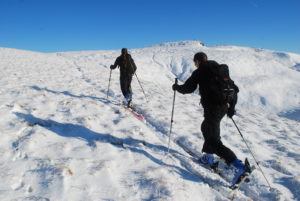Winter is coming. Ski season is imminent. If you don’t believe me, check out all the webcams from high up in the French and Italian Alps. Although there has been another long hot summer and a lot of the base snow melted, the white stuff is already falling, and there are hopes (as ever) of a decent amount of snowfall this side of Christmas, with the potential for another bumper year of skiing, boarding, and general slopeside fun.

Tim and Dave on James’s Thorn
All this is great news, it means that a lot of people are getting excited about new skis, new boots, new clothes, ski resorts, snow levels and are planning trips to fabulous winter wonderlands. To go along with the kit, those who are switched on are starting to flex their ski-specific muscles and are working on their fitness to ensure days and weeks of skiing, un-encumbered by needless injury, and with the feeling of well earned fatigue at the end of the day, rather than blasted out muscles that ache for rest at the first sign of a button lift.
Ah yes – button lifts… you remember them.
“So what are these ski-specific muscles” I hear you ask?
It isn’t quite as specific as that – of course you use the same muscles for a lot of things through the year, it is just that when skiing you are putting higher loads on the muscles for longer than you would do normally, resulting in fatigue (tiredness), and fairly often – pain.
Now this pain is not necessarily because of tissue damage and joint breakdown. No – it is generally the result of your muscles working far harder and longer than normal.
A way to mitigate this discomfort, to spend more time enjoying your time on skis and generally have a pleasant time strapped to 2 planks, is to get stronger. More strength and more strength endurance mean more fun!

Lynne and Tim in Austria
You don’t have to spend long each day working on you strength – obviously greater strength and greater dividends will be paid if you do – but just some base level work will stand you in good stead.
Squats – sets of 10 – pick up something heavy, If you can do more than 10 in a row, its too light
Lunges – lunge forward! Sets of 5 – hold onto something heavy
Single leg sit to stand – sit on a chair, stand up. Sit down – with control! If it is too hard, make it slightly easier by increasing the height of the chair with some towels.
Some kind of cardio – if you are able to process oxygen and get it to your muscles, you’ll be able to ski for longer with less fatigue. You’ll also be able to recover better – both overnight, and also while you’re having that afternoon gluwein.
Get strong, get breathing, have a great holiday!
Yes – we both Ski. Yes, we train people, and Yes, we train people to be stronger skiers- or whatever sport they decide to pursue. If you want some direction or tailored training for a specific objective, be it a holiday or a particular race, drop us a line.




